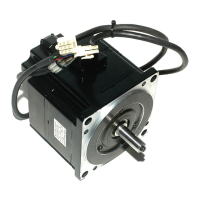
Do you have a question about the YASKAWA SGM series and is the answer not in the manual?
| Series | SGM |
|---|---|
| Category | Servo Drives |
| Feedback System | Incremental encoder, Absolute encoder |
| Communication Interface | MECHATROLINK-II, MECHATROLINK-III, EtherCAT |
| Control Modes | Torque control, Speed control, Position control |
User's manual for Sigma Series AC Servomotors and Drivers.
Important safety guidelines and precautions for using the products.
Critical notes for safe installation, operation, maintenance, and inspection.
Indicates hazardous situations that could lead to death or serious injury.
Indicates hazardous situations that could lead to minor injury or equipment damage.
Detailed warnings for wiring, operation, inspection, and maintenance.
Further cautions for receiving, installation, and wiring.
General precautions for using Sigma-Series products.
Explains the two-step process for safely conducting a test run.
Essential notes for safe use, including voltage types, pairing, and power handling.
Outlines the two-step test run procedure for safe and correct operation.
Details checks for wiring, motor operation, and I/O signals with the motor disconnected.
Guides on adjusting the Servopack for machine characteristics and performing autotuning.
Explains the concept of user constants and their division into memory switches and constant settings.
Addresses why the motor may not stop and describes methods for adjusting reference offset to 0 V.
Details how to use dynamic brake for stopping the servomotor.
Explains the zero-clamp function for stopping the motor and entering a servo locked status.
Describes the usefulness of holding brakes for vertical axis control and preventing load dropping.
Explains the autotuning feature for automatically measuring machine characteristics and setting servo gain values.
Guides on checking and resetting servo gain values after autotuning or for system optimization.
Explains basic wiring for alarm output signals and how alarm codes indicate alarm types.
Details how to wire and use the servo ON (S-ON) signal to control motor operation.
Specifies how to handle servo alarms that occur at power loss.
Details examples of wiring for noise reduction and correct grounding methods.
Describes how to connect both hand-held and mount-type digital operators to the Servopack.
Explains how to reset servo alarms using the digital operator or ALMRST input signal.
Details the four basic modes of digital operator operation: Status Display, Setting, Monitor, and Alarm Trace-back.
Guides on setting user constants, including memory switches and numerical settings.
Explains how to display and confirm past alarms for troubleshooting purposes.
Details how to operate the motor and perform basic checks using the digital operator.
Describes the autotuning function for automatic machine characteristic measurement and gain setting.
Explains how to automatically measure and adjust reference voltage offsets for speed and torque.
Describes how to manually adjust speed reference offsets for speed/torque control types.
Provides the procedure to clear the alarm history stored in the Servopack.
Guides on selecting SGM or SGMP servomotors based on type, capacity, voltage, and encoder specifications.
Details how to select an SGDA Servopack based on type, rated output, supply voltage, and model.
Provides causes and remedies for problems that cause alarm displays and those that do not.
Provides instructions for replacing the battery in servo systems using absolute encoders.
Provides tables to identify alarm causes and their remedies.
Lists common symptoms without alarms and their corresponding causes and remedies.
Covers important points and procedures for auto-tuning position-control Servopacks.
Details the cause and remarks for the Absolute data error alarm.
Explains the cause and remarks for the User constant breakdown alarm.
Covers the cause and remarks for the User constant setting error alarm.
Describes the cause and remarks for overcurrent alarms, indicating power transistor issues.
Explains the cause and remarks for position error pulse overflow alarms.
Details the cause and remarks for overvoltage alarms related to main circuit voltage.
Covers the cause and remarks for overspeed alarms when motor speed exceeds limits.
Explains the cause and remarks for overload alarms, indicating excessive motor and servopack load.
Details the cause and remarks for absolute encoder errors.
Explains the cause and remarks for absolute encoder back-up power supply failures.
Covers the cause and remarks for absolute encoder memory checksum errors.
Details the cause and remarks for absolute encoder battery voltage abnormalities.